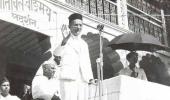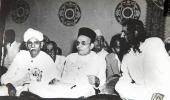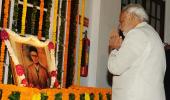The long queue outside the Cellular Jail is a testimony to its place in India's national consciousness.
The Andamans is also where the only British viceroy was assassinated and where Netaji unfurled the Tricolour for the first time in 1943, Archana Masih/Rediff.com discovers on a recent visit to Port Blair.

The queue on either side of the Cellular Jail is orderly. Dominated by honeymooning couples with hats, backpacks and water bottles, they stand under the elegantly lit prison walls, waiting for the gate to open for the evening's sound and light show.
There is a calm hush -- no bustling, jostling, noisy tourists, but a tidy bunch following the instructions of the traffic warden and staff outside.
As the gate opens, they troop in, making their way to the seat allotted in their ticket. A big white screen is set in the grassy ground, between two rows of cells -- the jail derives its name from the solitary cells -- . One can see the huge three-storied prison with wings emerging from a central point like the spokes of a bicycle.
Better known as Kala Pani -- black water or the exile of no return -- the jail is a national monument which is the first stop of every tourist to the Andaman islands.


Built like a starfish with rows of cells converging at a central watch tower, only 3 of the 7 wings remain. The structure is largely well maintained and visitors can walk about, unhurried, absorbing the brutal saga of Indian revolutionaries and the price they paid for India's freedom.
The sit-out under the peepal tree at the entrance of the Cellular Jail in Port Blair provides a cool spot for visitors when the hot April sun burns through the cap and scalds the top of one's head.
The tree has stood there as long as Cellular Jail has; a silent and living witness to the torture inflicted by the the British and then the Japanese during the latter's occupation of the islands during the Second World War.

It can be seen from the corridor outside Vinayak Damodar Savarkar's cell and must have been a measure of solace to him and other freedom fighters as they served long years of the harshest prison sentence meted out by the British in these islands far away from mainland India.
The peepal tree finds a mention in the sound and light show every evening. The two back to back shows are well-produced, the application of lights and moving images amongst the best one can see. The story of the sacrifices of freedom fighters projected on the very prison walls that imprisoned them.
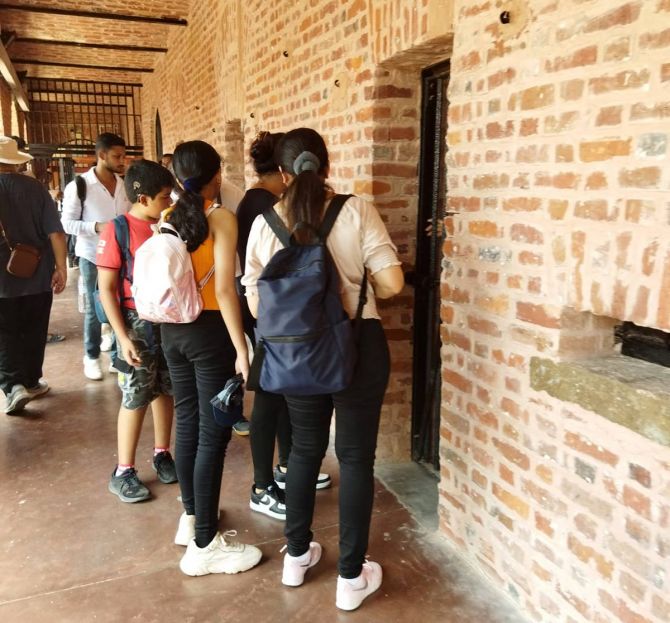
Veer Savarkar's cell lies at the far end of a long corridor on the third floor of the prison block facing the peepal tree. A brass plaque, two photographs and a mattress on the floor are the only articles in the stark cell where he spent 10 years in solitary confinement.
Visitors open the iron-gated door and step in, taking pictures on selfie sticks. Groups of Maharashtrian families make their way to see the freedom fighter from the state and the jail's most famous prisoner.
The beastly cruelty inflicted on the prisoners every day is depicted through a tableau of torture depicting how the prisoners were manacled, routinely flogged, harnessed as if they were cattle to a mill to produce coconut oil and hammer fibre out of coconut husk.

Convicts were flogged if they did not finish the task or extract the stipulated amount of oil. They spent the whole day doing this inhuman hard labour.
Statues of revolutionaries tied in chains, working at the oil mill and strung onto a flogging rack are exhibited -- and visitors stand alongside to get their photographs clicked.

The gallows are in a small hut at one corner of the ground. Three nooses still hang, depicting that three convicts were executed by hanging at a time.
No political prisoner was executed.
Built in 1906, the British constructed each cell in such a manner the front of one cell faced the back of another so that no prisoner could see another human being while inside his cell.
The central point of the three storied structure has row after row of marble boards with the names of the political prisoners from the states they come from.
The maximum are from Bengal -- 358, followed by Punjab -- 95.
Uttar Pradesh -- 18; Bihar -- 17; Kerala -- 14; Andhra Pradesh -- 8; Orissa - 5; Maharashtra - 3; Himachal/NWFP/Tamil Nadu/State unknown -- 27.

It was a stroke of coincidence that Mr Pandey, the taxi driver who dropped us to the prison entrance that evening, told us that he was a descendant of a freedom fighter who had been banished to the penal colony in the Andamans.
The British had started deporting revolutionaries to the islands after the Revolt of 1857 and used their labour to cut the hill at Port Blair to build the Cellular Jail between 1896 and 1906.
The soil that was dug out from the hill was used to create a cricket field for the British jailor, doctor and staff. They lived in bungalows on Ross Island -- across Port Blair -- with a clubhouse and bakery.

While the British staff lived in luxury, the Indian prisoners were fed gruel infested with worms and pebbles. Drinking water was cruelly rationed. Rodents scurried through the cells. An earthen pot was provided for use as a toilet inside the cell.
When prisoners went on a hunger strike to protest, they were force fed. A rubber tube was forced through the nose into the stomach. Three men -- Mahavir Singh, Mohan Kishore Namadas and Mohit Moitra -- died when milk entered their lungs. Their bodies were thrown into the sea.
The hour-long sound and light show is replete with the horrors such as these inflicted inside the prison gates.
Many prisoners succumbed to the torture, disease and loneliness; some met their death by hanging.

Andamans is where Viceroy Lord Mayo, the British empire's highest ranking official who ruled India in the crown's name -- was assassinated by Sher Ali, a former soldier after he had served a sentence in the Andamans.
On hearing that the viceroy was on a visit to Port Blair, Sher Ali waited till the viceroy climbed down from Mount Hariett. Lord Mayo was to board the ship that had brought him to Port Blair and return to the mainland. His wife had remained on the ship.
Sher Ali stabbed the viceroy at the bottom of the hill just as darkness fell. Lord Mayo bled to death on the ship.
Sher Ali was hung on Viper Island in 1872.
Lord Mayo is the only British viceroy to have been assassinated.

The beams of the sound and light show light up the Port Blair skyline and can be seen from the waterfront where a giant national flag flutters high above the residents who gather there every evening.
Netaji Subhas Chandra Bose hoisted the Tricolour for the first time at Port Blair in 1943 when the Japanese imperial forces who occupied the islands transferred power to the provisional government of the Azad Hind Fauj.
The flag on a 150 feet high mast flutters majestically as locals and tourists sit relaxed on the well-maintained site.
A semi-circular array of steps are provided under the flag that overlook the waterfront which is a great place to spend an evening in Port Blair.
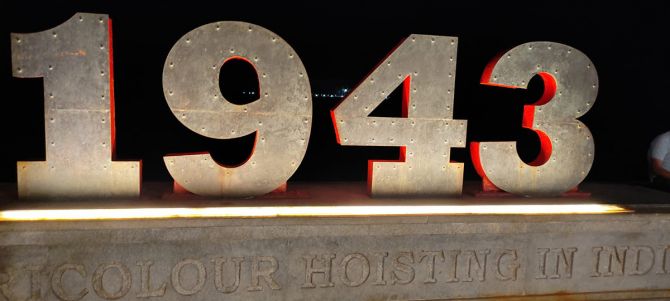


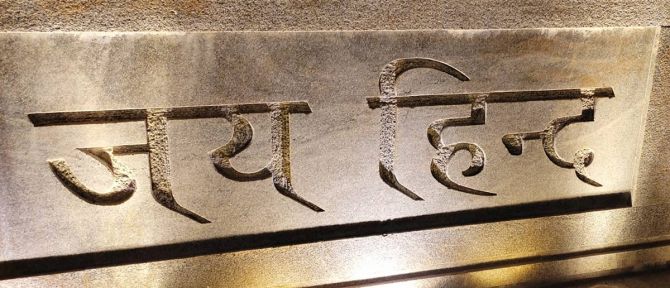
An important landmark in our nation's history, many freedom fighters fought the good fight on this island for Independence -- and it is a journey worth making to honour them.
Feature Presentation: Aslam Hunani/Rediff.com

